Why this resume works
- Quantifies accomplishments: Measurable accomplishments, such as reducing procurement costs by 15% annually and managing a $5M supply budget, reveal the applicant’s tangible impact.
- Showcases career progression: The path from sourcing coordinator to purchasing buyer highlights growth and increased responsibility, showcasing a dynamic career trajectory within the supply chain sector.
- Highlights industry-specific skills: Skills like supply chain optimization and vendor management show expertise in the industry, aligning perfectly with roles demanding strategic procurement capabilities.
More Purchasing Buyer Resume Examples
Take a look at our purchasing buyer resume examples to learn how to highlight your negotiation skills, vendor relations, and cost-saving achievements. These samples will help you build a purchasing resume that showcases your expertise in procurement.
Entry-Level Purchasing Buyer
Why this resume works
- Effective use of keywords: By integrating role-specific keywords like supplier negotiation and inventory management, the applicant strategically optimizes their resume for applicant tracking systems (ATS).
- Centers on academic background: Academic achievements, such as a master’s degree in supply chain management, emphasize a strong foundation in supply chain management early in their career trajectory.
- Shows digital literacy: The inclusion of certifications like Lean Six Sigma Green Belt showcases modern computer skills essential for data-driven procurement strategies.
Mid-Level Purchasing Buyer
Why this resume works
- Points to measurable outcomes: Achieving cost reductions of 15% and efficiency improvements of 20% reveals a results-driven mindset, showcasing the applicant’s ability to deliver measurable outcomes in supply chain roles.
- Displays technical expertise: Certifications such as Certified Purchasing Professional and expertise in cost analysis show the applicant’s technical mastery, strengthening their credibility in procurement and logistics optimization tasks.
- Includes a mix of soft and hard skills: Mixing analytical skills with interpersonal skills, the applicant balances supplier management, contract negotiation, and team leadership to excel in collaborative and technical environments.
Experienced Purchasing Buyer
Why this resume works
- Lists relevant certifications: Listing certifications like Certified Purchasing Professional and Supply Chain Analytics Certification on the resume shows commitment to expertise and ongoing learning.
- Showcases impressive accomplishments: By highlighting achievements such as reducing procurement costs by 15% annually, the applicant’s accomplishments reflect a high-impact approach to business efficiency.
- Focuses on work history: The applicant uses a chronological resume format, emphasizing an extensive work history that showcases progressive growth in roles across different companies.
Purchasing Buyer Resume Template (Text Version)
Chris Brown
Lakeside, CA 92057
(555)555-5555
Chris.Brown@example.com
Professional Summary
Experienced purchasing buyer with expertise in cost reduction and vendor management. Proven track record in optimizing supply chains, managing multimillion-dollar budgets, and achieving operational excellence.
Skills
- Negotiation
- Vendor Management
- Cost Reduction
- Supply Chain Optimization
- Budget Management
- Contract Administration
- Market Analysis
- Inventory Control
Certifications
- Certified Professional in Supply Management – Institute for Supply Management
- Supply Chain Professional Certification – APICS
Education
Master of Business Administration Supply Chain Management
Stanford University Stanford, California
December 2018
Bachelor of Arts Business Administration
University of California Berkeley, California
June 2016
Work History
Purchasing Buyer
Global Trade Partners – Lakeside, CA
January 2023 – August 2025
- Reduced procurement costs by 15% annually.
- Managed $5M supply budget efficiently.
- Implemented vendor evaluation improving quality.
Procurement Specialist
Supply Chain Innovators – San Francisco, CA
January 2020 – December 2022
- Optimized supplier contracts saving 10%.
- Streamlined purchasing process improving speed.
- Negotiated deals reducing inventory by 20%.
Sourcing Coordinator
Efficient Goods Corp – San Diego, CA
January 2019 – December 2019
- Coordinated orders increasing accuracy by 30%.
- Assessed supplier performance monthly.
- Led team reducing lead times by 25%.
Languages
- Spanish – Beginner (A1)
- Mandarin – Beginner (A1)
- French – Intermediate (B1)
Related Resume Guides
Advice for Writing Your Purchasing Buyer Resume
Discover insights on how to write a resume that highlights your skills in negotiation, supplier relationships, and cost management. Dive into specialized tips tailored for purchasing buyers to help you stand out and land that dream job.
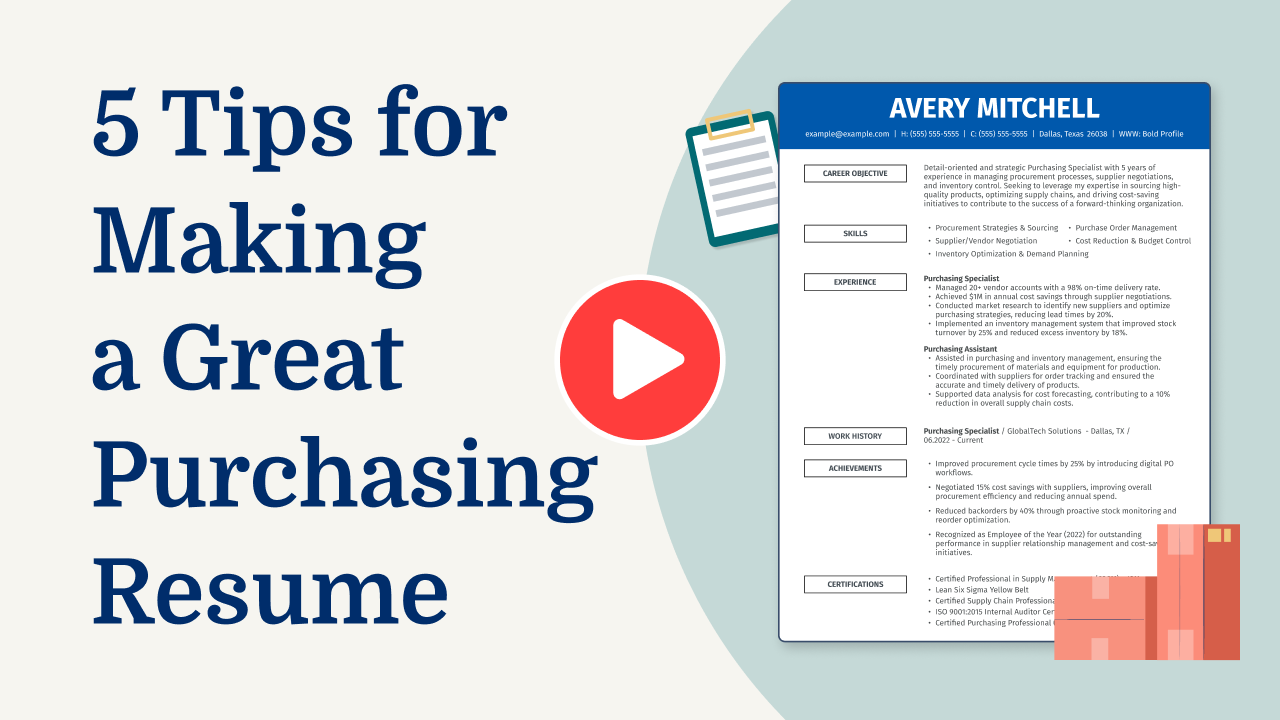
Highlight your most relevant skills
Listing relevant skills when applying for a job is important because it shows employers what you can do and how you fit the role.
For a purchasing buyer, highlighting both technical skills like vendor management and negotiation, as well as soft skills like communication and problem-solving, gives a balanced view of your capabilities. These skills tell employers that you not only know the nuts and bolts of the job but also can work well with others to get things done.
Creating a dedicated skills section on your resume helps you stand out by making it easy for hiring managers to spot your strengths quickly. This section should clearly list both kinds of skills—technical ones that show you can handle specific tasks and interpersonal ones that demonstrate you’re good at working in teams or leading projects.
Integrating key skills into your work experience makes an even stronger impact on your resume. Instead of just listing responsibilities, describe how you’ve used your skills in real situations. Mentioning how you’ve negotiated better prices or solved supply chain issues using these abilities makes your experience more relatable and convincing to potential employers.
Choose a resume format that highlights your negotiation skills, supplier relationships, and cost-saving achievements for a purchasing buyer role.
Showcase your accomplishments
When organizing your work experience as a purchasing buyer, list your most recent job first and work backward. For each job, include your job title, the name of the employer, the location, and the dates you worked there. This helps hiring managers quickly see where you’ve worked and how your career has progressed over time.
To make your resume stand out, focus on accomplishments rather than just listing duties. Use numbers to show your impact. For example, instead of saying “managed supplier relationships,” say “negotiated contracts that reduced costs by 15%.” This shows not only what you did but also how well you did it. Use action words like “increased,” “decreased,” or “improved” to describe what you’ve achieved in your role.
Quantifying accomplishments is key because it gives potential employers a clear picture of what you can do for them. It makes it easy for them to see how you made a difference in past jobs and what kind of impact you might have at their company. By showing measurable results, you’re more likely to catch a hiring manager’s eye and land an interview.
5 purchasing buyer work history bullet points
- Negotiated supplier contracts, achieving a 10% cost reduction and saving $200,000 annually.
- Streamlined purchasing processes, reducing procurement cycle time by 25% and increasing order accuracy.
- Managed inventory levels efficiently, decreasing excess stock by 15% and improving cash flow.
- Sourced new suppliers that improved product quality, resulting in a 20% increase in customer satisfaction scores.
- Led cross-functional teams to implement a new procurement system, cutting order processing time by 30%.
Choose a resume template featuring clean lines and clear sections for easy readability. Avoid heavy graphics or fancy fonts, ensuring your skills and work take center stage.
Write a strong professional summary
A professional summary on resumes serves as an introduction to hiring managers. It helps readers decide whether to use a summary or objective statement. A strong professional summary can make a great first impression and quickly highlight your qualifications.
A professional summary is typically three to four sentences that show your experience, skills, and achievements. It is best for experienced applicants and aims to present your professional identity and value to potential employers.
In contrast, resume objectives are statements of career goals. They work well for entry-level job seekers, those changing careers, or people with employment gaps. While summaries focus on “what I’ve accomplished,” objectives emphasize “what I aim to contribute.”
Next, we’ll provide examples of both summaries and objectives tailored for different industries and experience levels. Explore our extensive library of resume examples for additional inspiration.
Purchasing buyer resume summary examples
Entry-level
Recent graduate with a Bachelor of Science in supply chain management, trained in procurement processes and inventory management. Completed an internship with ABC Corporation, gaining exposure to vendor negotiations and purchase order processing. Eager to apply analytical skills and knowledge of purchasing software in a dynamic buying team.
Mid-career
Purchasing buyer with over seven years of experience in the electronics industry, known for reducing costs through strategic supplier partnerships. Proficient in contract negotiation, demand forecasting, and managing cross-functional projects. Achieved a 15% reduction in material costs at DEF Tech by implementing innovative sourcing strategies.
Experienced
Accomplished purchasing buyer with 15+ years of expertise in global supply chain operations and team leadership. Specialized in developing procurement strategies that align with organizational goals and improve operational efficiency. Successfully led a team at GHI Industries to decrease lead times by 20%, leveraging advanced data analytics and supplier relationship management.
Purchasing buyer resume objective examples
Recent graduate
Detail-oriented recent graduate with a Bachelor of Science in supply chain management seeking an entry-level purchasing buyer role. Eager to apply analytical skills and knowledge of procurement processes to support strategic sourcing and vendor relationships in a fast-paced company.
Career changer
Resourceful professional transitioning from a career in sales into purchasing buyer roles, bringing strong negotiation skills and customer-centric mindset. Looking forward to contributing to efficient inventory management and cost-effective purchasing strategies within a dynamic organization.
Specialized training
Aspiring purchasing buyer with specialized training in supply chain analytics eager to join an innovative retail company. Passionate about using data-driven insights and market research techniques to optimize purchasing decisions and improve product availability.
Save time and stress by using our Resume Builder to create a professional-looking resume, making it easier to highlight your skills as a purchasing buyer.
Match your resume to the job description
Tailoring your resume to match job descriptions is important for standing out to employers and bypassing applicant tracking systems (ATS). These systems scan resumes for specific keywords and phrases from the job postings.
An ATS-friendly resume includes relevant keywords that align with your skills and experiences. This boosts your chances of being noticed by hiring managers. By using the right words, you show that you understand what the employer is looking for in a purchasing buyer.
To find these keywords, carefully read the job posting. Look for skills, qualifications, and tasks mentioned multiple times. For example, if a job mentions “vendor management,” “inventory control,” or “cost reduction,” incorporate those exact phrases into your resume. When you customize your resume with these words, it’s more likely to catch the attention of hiring managers.
Incorporate these terms naturally into your content. Instead of saying “Managed vendors,” say “Managed vendor relationships to ensure timely delivery and cost savings.” This shows how you applied a skill directly related to the job description.
Using targeted resumes improves ATS compatibility and makes it easier for employers to see how well-suited you are for the role. By matching your resume to each job description, you’re more likely to get interviews and opportunities as a purchasing buyer.
Check your resume with our ATS Resume Checker to find over 30 common mistakes in layout and wording. Instantly see tips on how to boost your resume’s score!
FAQ
Do I need to include a cover letter with my purchasing buyer resume?
Yes, including a cover letter with your purchasing buyer resume can improve your application and increase your chances of getting noticed.
A cover letter allows you to express your enthusiasm for the role and highlight specific experiences that align with the company’s needs, such as successful negotiations or cost-saving strategies.
If the company has a particular focus, like sustainable sourcing or international logistics, emphasize your experience or interest in these areas to demonstrate your fit. Consider using our Cover Letter Generator to craft a personalized cover letter based on your resume details.
You can also start from scratch with expert suggestions tailored to your career goals. Additionally, exploring cover letter examples can provide inspiration and guidance tailored to purchasing roles across different industries.
How long should a purchasing buyer’s resume be?
For a purchasing buyer, the length of your resume often depends on your level of experience. A one-page resume is perfect for those with limited experience or just entering the field, as it effectively highlights key skills such as vendor management and cost analysis.
If you’ve accumulated significant professional experience or possess specialized certifications, a two-page resume might be more appropriate to capture all relevant details.
It’s important that every entry emphasizes your ability in procurement processes and supplier negotiations. Explore our guide on how long a resume should be for further insights tailored to different career stages.
How do you write a purchasing buyer resume with no experience?
To create a purchasing buyer resume with no experience, focus on showcasing relevant skills, education, and projects that highlight your potential. Start by customizing your resume to emphasize what you can contribute to the role. Here are a few tip:
- Highlight transferable skills: Skills like negotiation, analytical thinking, and attention to detail are valuable for purchasing roles. If you’ve honed these through coursework or volunteer activities, make sure they’re front and center.
- Include relevant coursework or projects: If you’ve studied supply chain management, business administration, or taken specific courses related to purchasing, list them along with any relevant projects where you applied these concepts.
- Showcase internships or volunteer work: Experience doesn’t always mean paid roles. Any internships or volunteer positions that required budgeting, procurement tasks, or vendor communication are worth mentioning.
Check out our guide on writing a resume with no experience for more examples and tips from Certified Professional Resume Writers.
Rate this article
Purchasing Buyer
Additional Resources
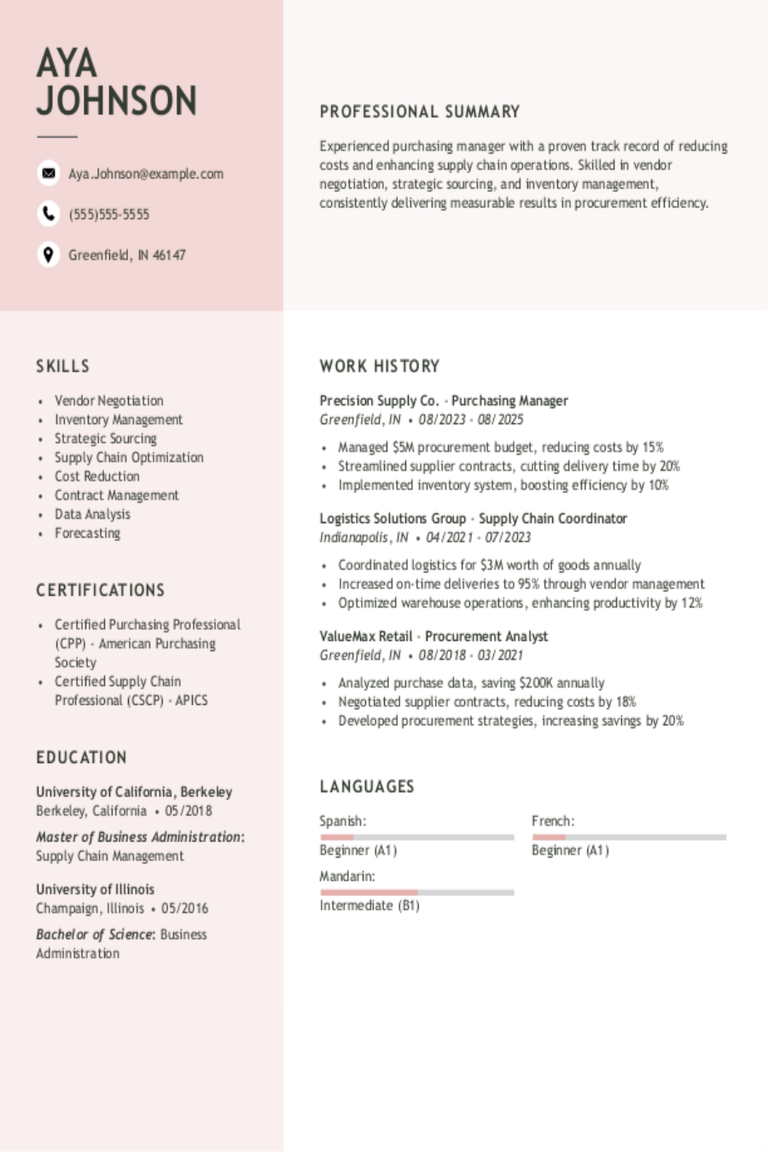
Purchasing Manager Resume Examples & Templates for 2025
Browse purchasing manager resume examples and tips to learn how to highlight skills in smart spending, vendor relationships, and keeping inventory on track.Build my resumeImport existing resumeCustomize this templateWhy this
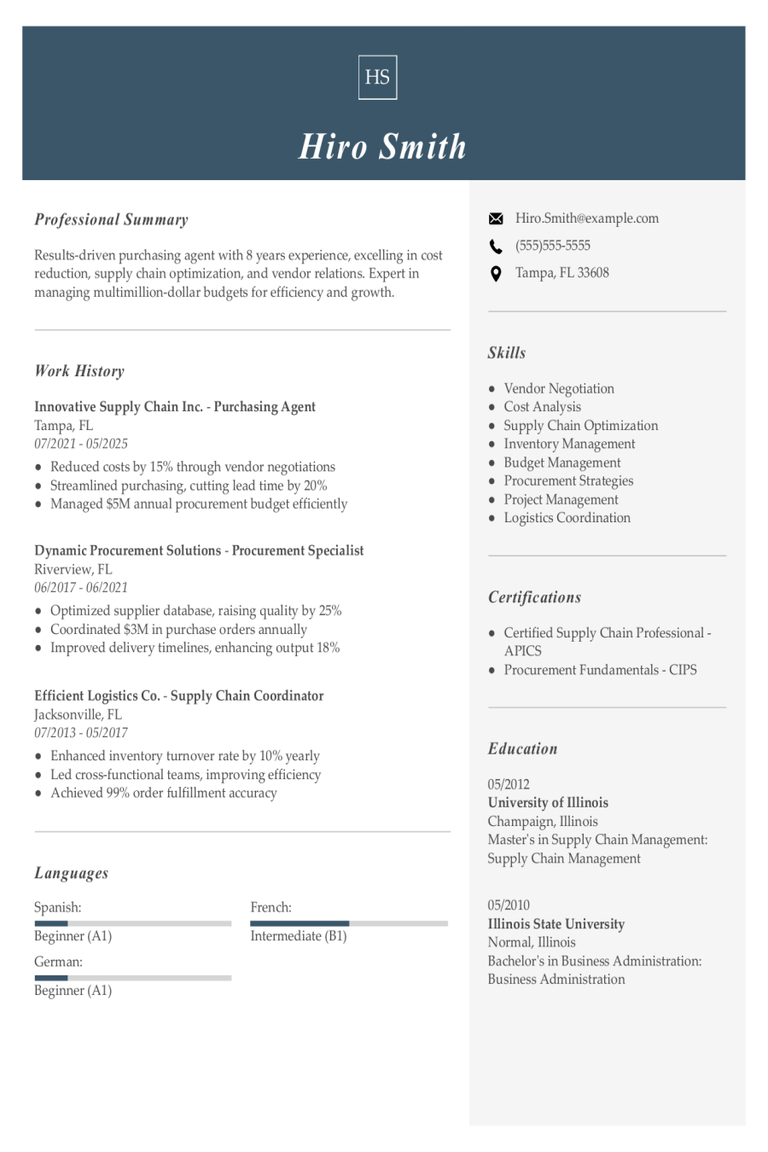
Purchasing Agent Resume Examples & Templates for 2025
Explore purchasing agent resume examples that showcase skills like negotiation, supplier management, and cost-saving. Learn how to make your experience stand out to hiring managers.Build my resumeImport existing resumeCustomize this
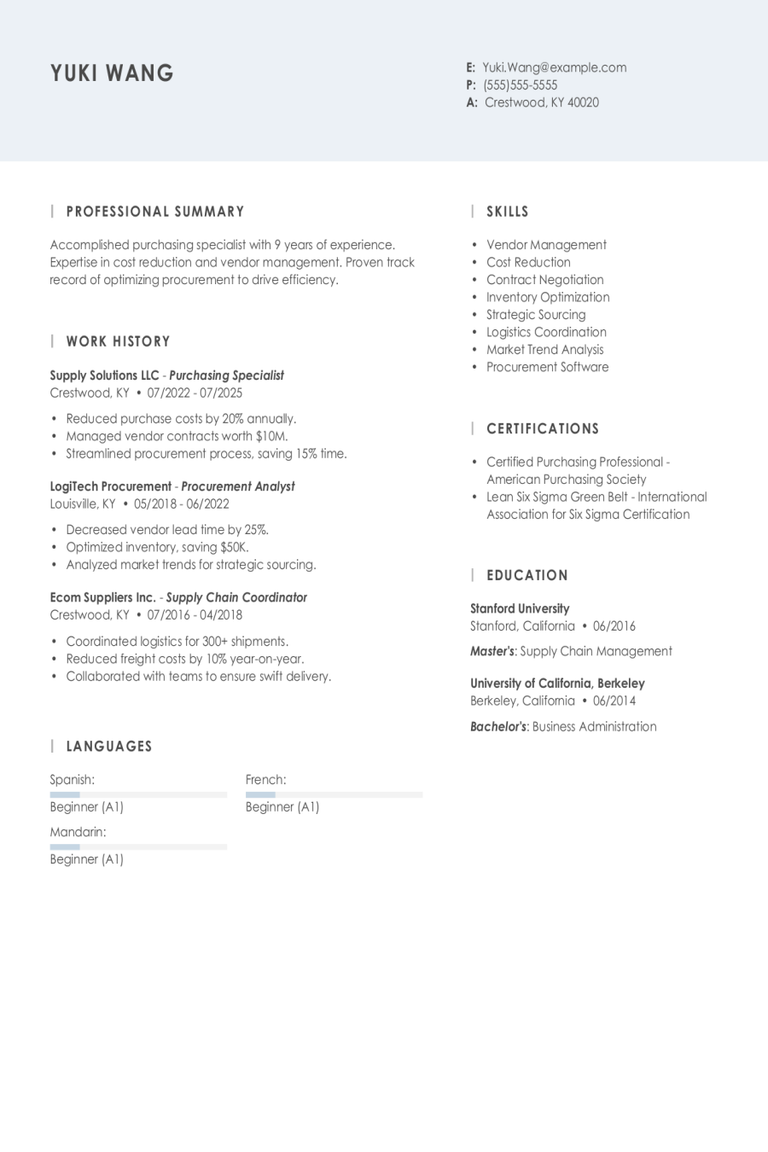
Purchasing Resume Examples & Templates for 2025
Learn how to show your ability to find the best deals and manage budgets on your purchasing resume. Use our examples and tips to help you showcase your negotiation skills
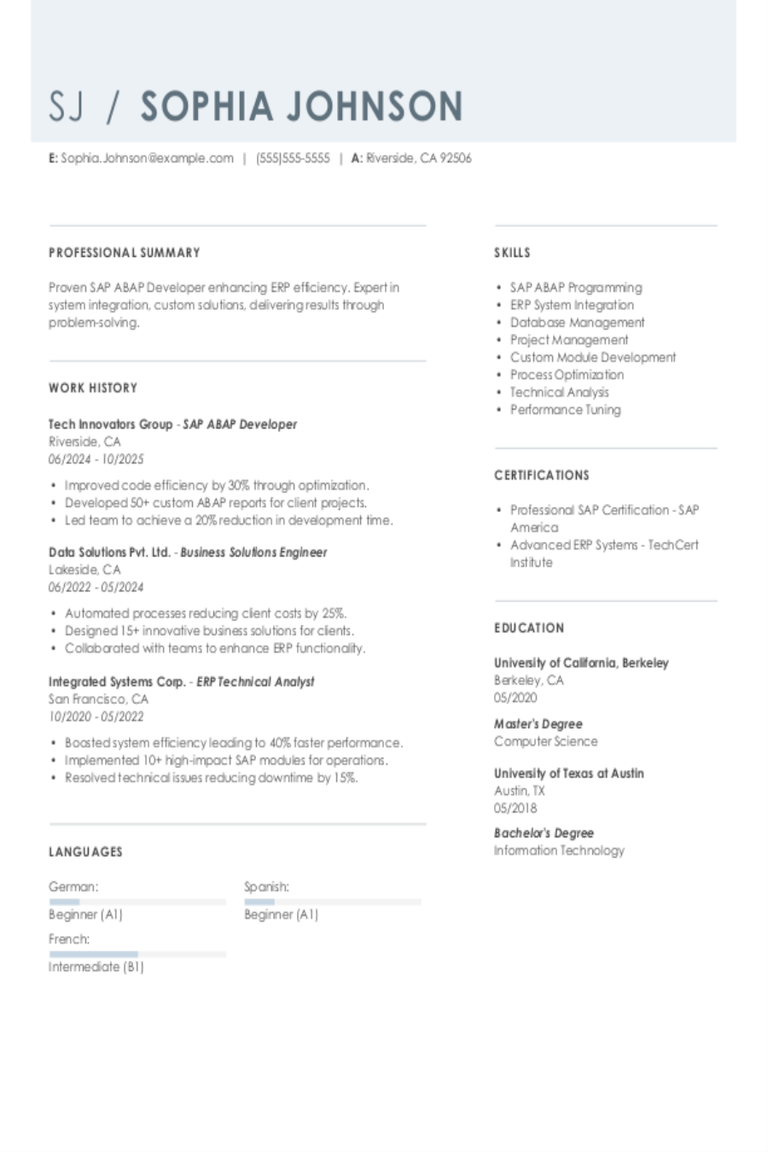
SAP ABAP Developer Resume Examples & Templates for 2025
Explore SAP ABAP developer resume examples and tips to learn how to spotlight your skills in coding, debugging, and system enhancements to stand out to hiring managers.Build my resumeImport existing
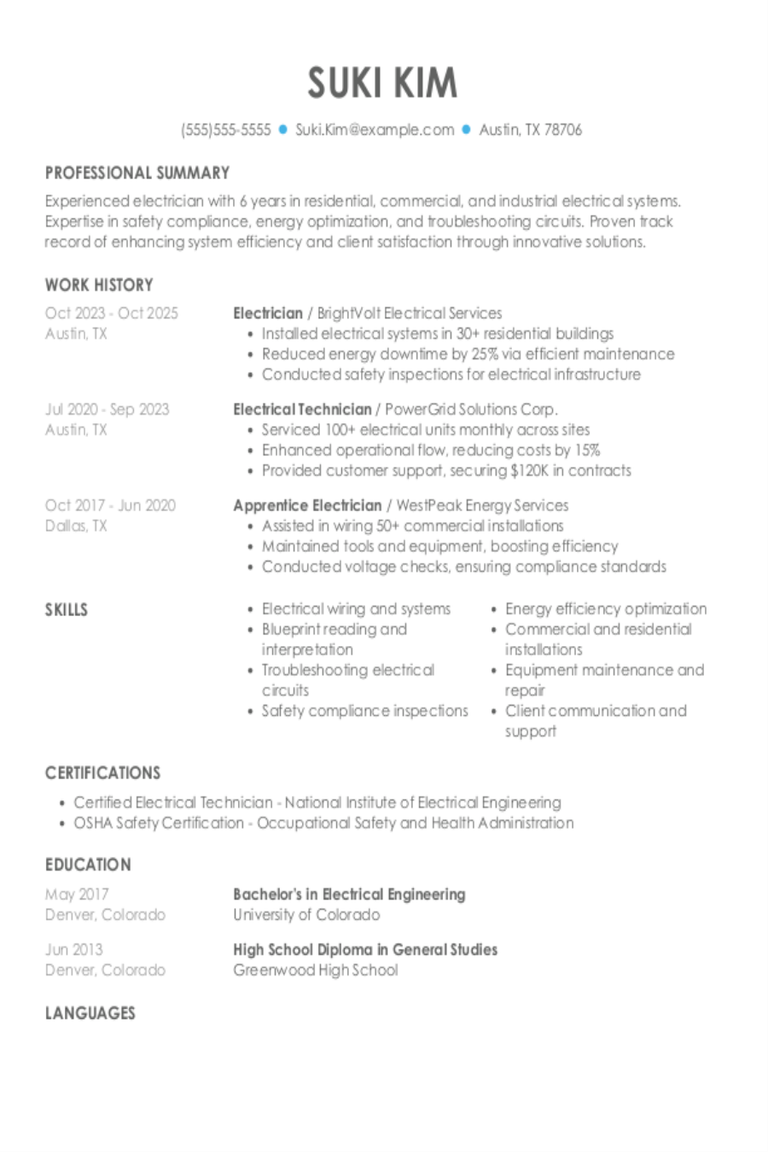
Electrician Resume Examples & Templates for 2025
Explore electrician resume examples to learn how to spotlight your wiring, troubleshooting, and safety skills. See how to emphasize your knowledge of electrical codes and highlight your experience across various
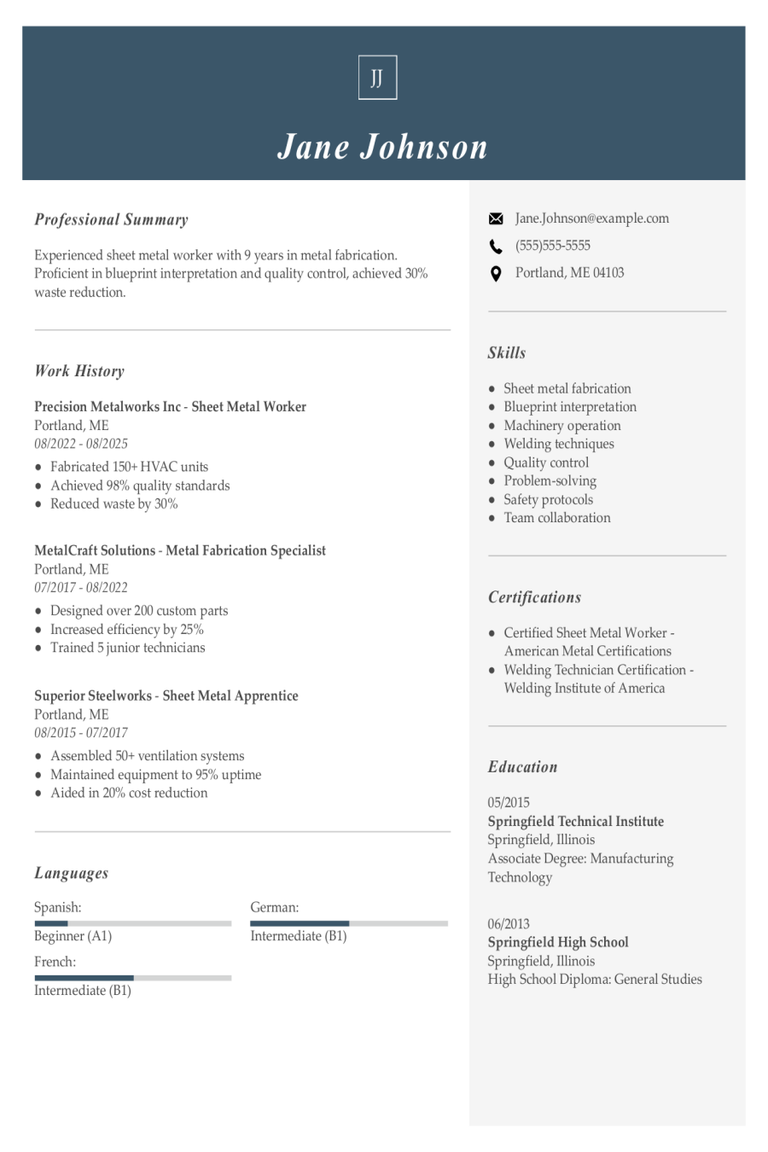
Sheet Metal Worker Resume Examples & Templates for 2025
Browse sheet metal worker resume examples and tips to learn how to highlight your hands-on experience and problem-solving abilities to stand out to recruiters and hiring managers.Build my resumeImport existing
